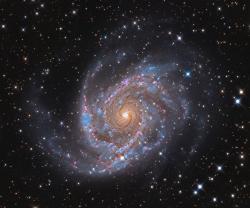
Howdy, Stranger!
It looks like you're new here. If you want to get involved, click one of these buttons!
BlockHead
About
- Username
- BlockHead
- Joined
- Visits
- 257
- Last Active
- Roles
- Member, Administrator
Comments
-
Bruce, You need to refine your question. You are showing two different types of files. One of them apparently was calibrated in Pixinsight with WBPP. The other, the FITS, ...I don't know... maybe this is raw data? That is a different kind of project…
-
COncerning your last statement..correct. I think the issue is polar alignment...not vibration. I think you are making this too hard. You do not need any special software!Just point your telescope on the meridian near due south on the celestial equa…
-
Looks pretty good. Drift align requires you to point the telescope on the meridian (due south) around around 0 degrees in declination (the celestial equator). I KNOW you can see this... this is where the horsehead nebula is.The south point will corr…
-
You can polar align... let me start there. If you can see south and either east or west, you use the drift method. It only takes a few minutes once you know how to do it efficiently. If you take pictures at a gain of 100 and you see star trails then…
-
How light behaves with different filters in the presence of other optical surfaces is complex. For example you note that one (of many) paths light can take is to come through the filter, be reflected up to the backside of the filter from the sensor …
-
Mark, You did not explicitly say your complete data set. I infer you just have Ha and OIII... but given more: 1. RGB stars to replace NB stars. Best.2. Remove Halo from starless image if mostly found there and reassemble. Since embedded in nebulosit…
-
No other suggestions..that is indeed the best way to proceed. You can attempt to incorporate my structure elimination technique. I show how this is done in Comet Academy in a few places. https://www.adamblockstudios.com/articles/comet-academy-comet-…
-
No... there isn't really anything you can do about it if the stray light is coming from specular reflections of your sensor/camera. The solutions are all pretty much the messy cosmetic manipulations. -the Blockhead
-
That is why I asked and commented in my original answer.Thanks-the Blockhead
-
It is certainly a technique that should be known and used if it can be helpful. -the Blockhead
-
A screenshot would help me understand!You know..this IS all about images... But yes, this one *might* be helpful:https://www.adamblockstudios.com/articles/scattered-light Is this what you are looking for? -the Blockhead
-
I haven't had time to look into it deeply. Some graphs would be great!lol -the Blockhead
-
It depends. If the scattered/reflected light is strongly a particular color- it is possible to use substitution (from the other colors) to replace or adjust the offending pixels. If there isn't a way to distinguish the obtrusive light from other ele…
-
Oh..I see. Yes, if the field is illuminated strongly that can happen. Assuming you took these data in some kind of sequence you can see the effect of moonlight on the data by blinking the images. -the Blockhead
-
Perhaps... but you probably want to determine the stretch on what is necessary for the object. Then... if the stars are not to your liking... you would make adjustments based on this final stretch. One method is to stretch the stars independently o…
-
Well.. star halos are a real part of the data. I know the in the future Russ/BXT/SXT will likely have leverage in this area. (But I do not want to say more.)It depends on the type of halo (big, or small, colored or not...etc etc). Usually touching t…
-
I will answer as many questions from members as quickly as I can. Yes, there does appear to be an element of polling for answers from other sources by some members. I honestly can't keep track- but I am interested in making the heartbeats I spend in…
-
Yes, of course. Consider broadband imaging- your light source is certainly not going to emit light equally in each color and your sensor isn't going to detect light equally in each wavelength/color and your filters do not transmit light quality at w…
-
I will not be able to help you out. I found that the information Dr. Glover talks about is incomplete because it does not take into account other aspects of image processing. If your ideal exposure time is 66 seconds- what is the increase in the tot…
-
Just to be clear... looking at the final integrated image usually isn't that helpful other than to identify something isn't optimal.-the Blockhead
